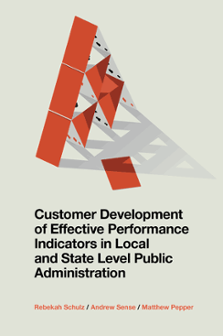
Index
Rebekah Schulz
(Georges River Council, Australia)
Andrew Sense
(University of Wollongong, Australia)
Matthew Pepper
(University of Wollongong, Australia)
ISBN: 978-1-83982-149-3, eISBN: 978-1-83982-148-6
Publication date: 3 March 2021
This content is currently only available as a PDF
Citation
Schulz, R., Sense, A. and Pepper, M. (2021), "Index", Customer Development of Effective Performance Indicators in Local and State Level Public Administration, Emerald Publishing Limited, Leeds, pp. 125-126. https://doi.org/10.1108/978-1-83982-148-620211009
Publisher
:Emerald Publishing Limited
Copyright © 2021 Emerald Publishing Limited
INDEX
Australia, community engagement practices in
, 6
Balanced scorecard (BSC)
, 23
Bias
, 60
Community engagement practices
, 6
Confirmation of VoC and TR
, 73–76
Consolidation of VoC lists
, 68–70
Critical decision
, 35–40
PIHoQ in
, 41
Cultural precincts
importance and satisfaction ratings of
, 35
performance indicators
, 83
PIHoQ
, 42, 45–46
sample TRs for
, 28, 30
stakeholder comments related to performance indicators
, 85–86
VoCs placement in PIHoQ
, 24
Customer-related TRs, sample performance indicators for
, 33
Customers
, 2, 21–22
Demographic analysis
, 52
External stakeholders
, 2
development of VoC outputs
, 64–67
focus groups
, 57
images of facilities and services
, 61
open discussion on services and facilities
, 61
participants drawing/writing expression of service/facility
, 61
prioritisation of VoCs
, 63
room layout
, 58
sessions
, 60
VoCs of service/facility
, 62–63
House of Quality (HoQ)
, 2, 6–7, 10, 13, 15–18, 21, 110 (see also Performance Indicator House of Quality (PIHoQ))
Imagery used in cultural precinct VoC focus group session
, 58–59
Importance-performance analysis
, 35
Institute of Public Administration of Canada (IPAC)
, 5
Intangible performance indicators (IPIs)
, 32, 84
utilisation
, 47–48, 104–105
Internal stakeholders
, 53–54 (see also External stakeholders)
focus groups
, 67–68
Mapping
exercise
, 77–78
of VoC and TR relationship matrix
, 78–81
Participative action research process (PAR process)
, 7–8, 108
Performance assessment
, 6
Performance indicator development assemblage (PIDA)
, 7, 107
key messages
, 112–113
potential benefits
, 107–110
potential challenges and opportunities
, 111–112
questions
, 113–114
Performance Indicator House of Quality (PIHoQ)
, 7, 10, 13, 18–21, 49
areas of deployment
, 39–47
confirmation of PIHoQ and components and deciding areas of deployment
, 99–104
confirmation of VoC and TR
, 73–76
critical decision
, 35–39
framework
, 22
importance and satisfaction ratings
, 34–35
learning from
, 44, 47
mapping exercise and TR relationship matrix
, 77–78
mapping of VoC and TR relationship matrix
, 78–81
outputs and outcomes
, 82–86
plotting of critical decision
, 95–98
sample TRs for cultural precinct
, 28, 30
stakeholder selection and VoC development
, 50–70
surveying importance and satisfaction ratings
, 87–94
TR
, 24–27
TR relationship matrix
, 27–29
TRs development
, 71–72
VoC
, 21–24
VoC and TR relationship matrix
, 29–31
Performance indicators
for cultural precincts
, 84
customer approach to performance indicator development
, 6–8
customers collaboration in development of
, 3–4
and measuring performance in PA
, 4–6
outputs and outcomes
, 32–34
Performance measurement
, 5
Performance measures
, 4
PricewaterhouseCoopers (PwC)
, 9
Prioritisation of VoCs
, 63
Public administration (PA)
, 1, 13
customer approach to performance indicator development
, 6–8
customers collaboration in development of performance indicators
, 3–4
performance indicators and measuring performance in
, 4–6
quality-oriented perspective to performance indicator development in
, 1–3
Public organisations
, 1–2
Quadrant graph
, 37–39
Quadruple bottom line (QBL)
, 23
Quality function deployment (QFD)
, 2–3, 13–15
Quality management
, 2, 13
Quality perspective
HoQ
, 15–18
and performance indicators in PA
, 13–14
PIHoQ
, 18–20
QFD
, 14–15
Stakeholder
and analysis of participants
, 51–56
analysis rainbow
, 54–56
expectations
, 22
participation
, 5
selection
, 50
Tangible performance indicators (TPIs)
, 32, 84
utilisation
, 47–48, 104–105
Technical requirements (TRs)
, 2, 16–17, 21, 24, 49
confirmation of VoC and TR
, 73–76
for cultural precincts
, 72
development
, 71–72
example
, 26–27
implementing VoCs in administering authority
, 24–27
refining
, 30–31
relationship matrix
, 27–29, 77–78
representative TRs for NSW local government authority
, 26
Total Quality Management
, 2, 14
Voice of the customer (VoC)
, 2, 15, 21–24, 49, 110
alignment of VoCs with categories
, 68
average rating
, 92–93
confirmation of VoC and TR
, 73–76
development
, 50–70
for importance rating
, 89–90, 92–93
prioritisation of
, 63, 88
and TR relationship matrix
, 29–31